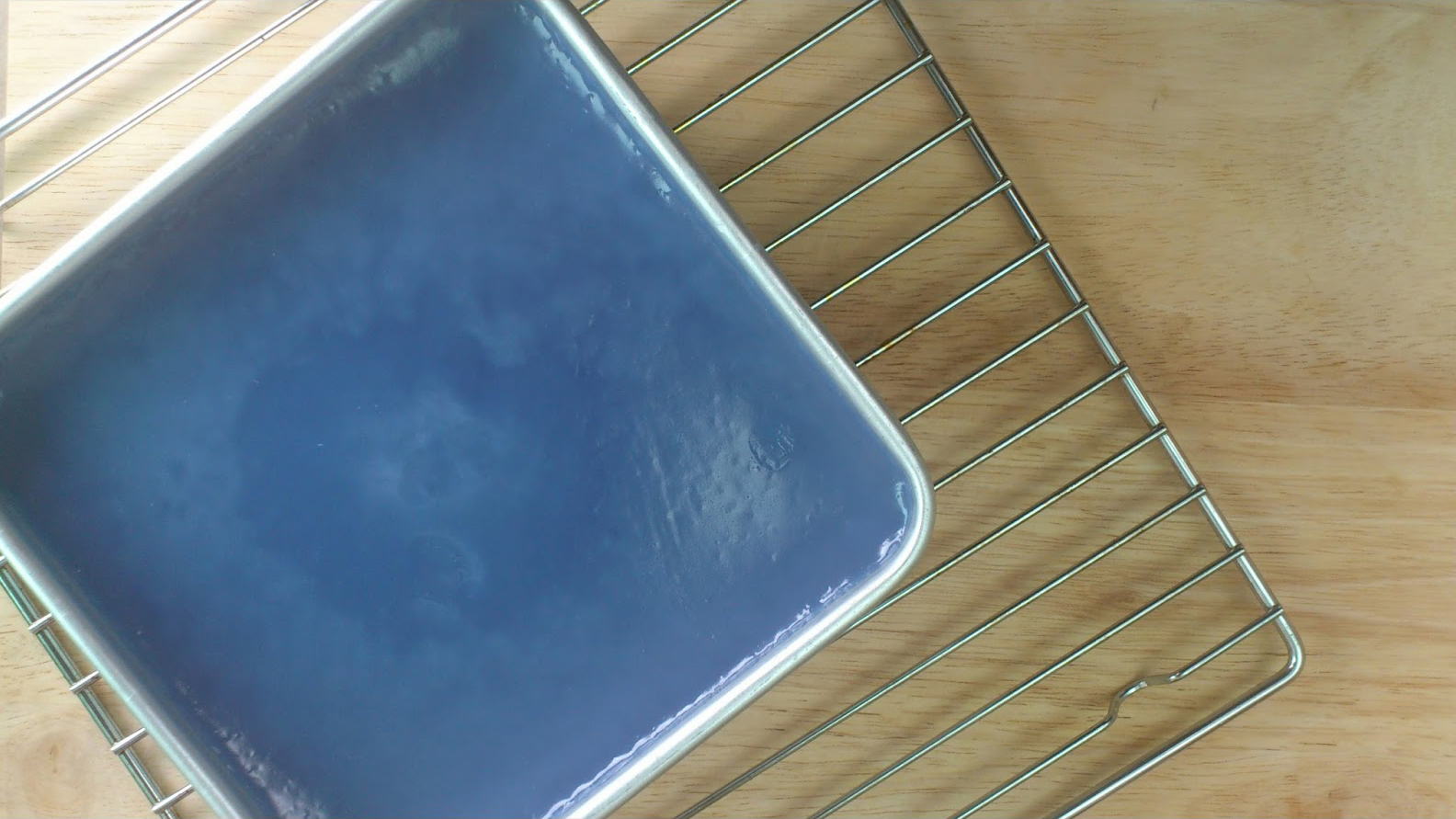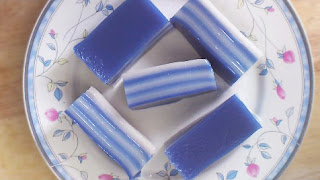Kueh Lapis (I)

Kueh lapis is a colourful kueh that’s steamed layer by layer. It’s sweet, and it tastes of coconut milk and pandan leaves. Tapioca starch, the main ingredient, makes the texture chewy and elastic.
Kueh lapis, take one: So there I was, poking the first layer of my nine-layer kueh lapis with a pair of chopsticks. Yup, it’s cooked! At this point, other people would proceed with steaming the second layer, but not me.
Snip, snip, went my scissors. Then, I popped a small piece of single-layer kueh lapis in my mouth.
Ouch, ouch, it’s hot . . . . Mmm, not bad!
The recipe was from “Cooking for the President”, my go-to cookbook when I need help with local recipes.
After making sure the kueh lapis wasn’t too hard, too soft, too sweet, too lemak, or too bland, I steamed the second layer, then third, fourth . . . . Uh oh, problem!
Each layer took five minutes to cook. That left me idling and bored, so I kept lifting the lid on the steamer to have a peek, and poke the kueh a bit.
The kueh lapis was a flop. The layers didn’t stick together and each one, except the bottommost, was hard at the bottom. I threw away the kueh, reread the recipe, and realized I made two mistakes.
First, the kueh cooled down a bit whilst I was peeking and prodding. When that happened, the top surface lost its stickiness, so it couldn’t stick to the next layer. Conclusion: no peeking. Or at least peek and then reheat the steamer thoroughly, before making the next layer.
Second, the layers I made were too thick. As a result, they cooked/solidified too slowly. The rice flour in the liquid batter had time to sink and form a hard bottom for each layer, except the bottommost. Why was the first layer different? Because it didn’t have any cooked layers at the bottom, acting as a heat shield, so it thickened and cooked through more quickly and evenly.
Kueh lapis, take two: I followed the recipe exactly, and got myself something to read. This time, I had a taste only after all nine layers were done.
Piping hot and soft, the kueh lapis seemed like a great success.
Once it was cold, however, two problems emerged. First, it didn’t have the stretchy, elastic texture it had before it cooled down. Second, the layers weren’t sticking together properly – again.
Kueh lapis, take three: The recipe specified 80% tapioca flour, which stretches like Elastigirl after it’s steamed, and 20% rice flour which doesn’t. For the third attempt, I omitted the rice flour and used only tapioca flour. And when I topped up the steamer, I added boiling water from the kettle, after the previous layer of batter was cooked. I then let the steamer heat back to a rolling boil before making the next layer.
In take two, I added batter and topped up the steamer at the same time. Even though I used almost boiling water, the steamer stopped boiling for maybe 20 seconds. That was enough to make the layers separate.
Why didn’t I put lots of water in the steamer so that no topping up was necessary? Because the kueh pan, before it had enough batter to weigh it down, would bob up and down if the water level was too high. Lastly, I steamed each layer a little thicker than in take two – 3 mm instead of 2 mm – because the pesky rice flour was out of the way.
With the three amendments, my kueh lapis finally had nicely formed layers and the right texture. This time, I gave it several hours to cool down and set before having a piece.
I can finally make kueh lapis that I’m quite happy with. Gonna die in peace now . . .

Kueh Lapis
Video
Ingredients
- 50 fresh bunga telang (blue pea flowers) or any artificial food colour you like
- 4 pandan leaves
- 185 g sugar
- ⅓ tsp salt
- 400 ml undiluted freshly squeezed coconut milk
- 200 g tapioca starch
Instructions
- If using bunga telang, rinse flowers gently. Drain. Blot gently with paper towels. Pound finely. Strain to yield 2-3 tsp juice. Set aside. Discard pulp.50 fresh bunga telang (blue pea flowers)
- Rinse pandan leaves. Cut 10 cm long. Simmer gently for 5 minutes in enough water to cover. Discard leaves. Measure 160 ml from the pandan water and discard excess, or top up with water as necessary if you're short.4 pandan leaves
- Put pandan water back in the pot. Add sugar and salt. Stir over low heat till salt and sugar dissolve. Turn off heat. Add coconut milk. Stir till evenly mixed. Add tapioca starch. Mix thoroughly. Strain into a mixing bowl. Push undissolved starch through strainer.185 g sugar, ⅓ tsp salt, 400 ml undiluted freshly squeezed coconut milk, 200 g tapioca starch
- Weigh 270 ml from the batter. Add flower juice made earlier, or any food colour you like. Stir till evenly mixed. You now have 2 lots of batter, one blue and one white.
- Bring kettle to the boil and set aside.
- Rinse 15-cm square cake tin to make it wet. Line bottom with parchment paper.
- Bring steamer to a rolling boil. Pour enough white batter into cake pan to form a layer 3 mm thick, about 100 ml. Place pan in steamer. Steam 5 minutes over rapidly boiling water. Steam another layer of white, then blue. Repeat the white-white-blue sequence twice, making 9 layers in total.
- Each layer needs about 90 ml batter, other than the first one. Stir batter to mix starch evenly before measuring each round of batter. Have measured batter ready before lifting lid on steamer. Once lid is removed, quickly pour batter into cake tin and cover steamer. Every layer is steamed 5 minutes except the topmost, which gets 10 minutes.
- Make sure steamer doesn’t boil dry. To top up steamer: a) wait till previous layer of batter is cooked; b) reboil water in kettle; c) add boiling water to steamer as necessary; d) bring steamer back to a rolling boil, covered. After step 4, proceed to steam more layers as described above.
- When all 9 layers are done, remove kueh lapis to a wire rack to cool down completely and set, about 3 hours.
- To unmould kueh, loosen edges with a knife. Cover top of kueh with parchment paper to keep it clean, then turn cake tin upside down and knock firmly against chopping board till kueh falls out. Discard top parchment paper. Cut kueh by pressing knife downward, i.e. do not saw. Discard bottom parchment paper. Serve within 2-3 hours, or refrigerate to stop kueh from spoiling.